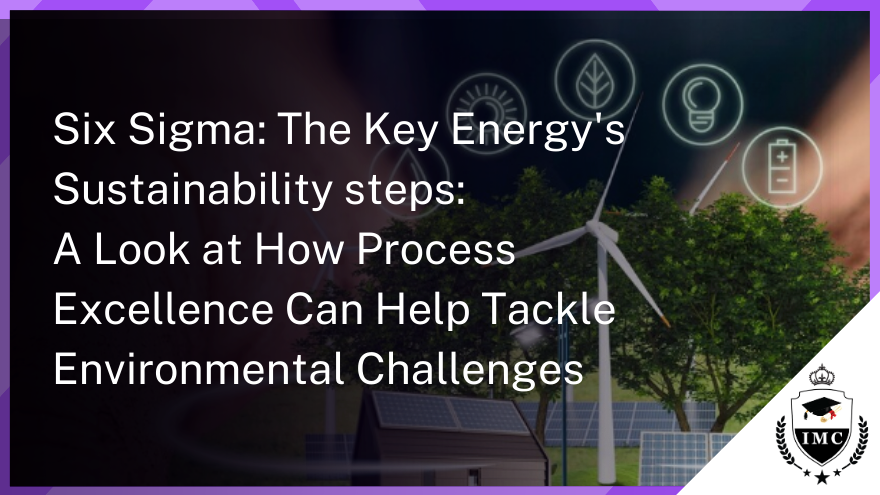The energy industry is facing immense environmental challenges today. With rising carbon emissions and climate change concerns, energy companies are under tremendous pressure to reduce their ecological footprint. At the same time, they must meet the ever growing energy needs of modern society in an economically viable way. This creates a complex balancing act for energy businesses. Six Sigma provides a structured, data-driven approach that can help energy companies improve sustainability by enhancing efficiency and minimizing waste. The statistical and process improvement tools of Six Sigma, combined with its cultural principles of leadership commitment and fact-based decisions, give the energy sector a framework to integrate environmental priorities into operations in a profitable manner. This article explores how Six Sigma's methodological pillars of reducing process variability, optimizing energy usage tracking, disciplined project prioritization and implementation, and instilling an eco-conscious culture can drive greener practices across the energy value chain. It demonstrates how techniques like statistical process control, measurement systems analysis,
Reducing Energy Waste through Process Improvement
A core principle of Six Sigma is reducing variability in processes. In energy production, variability leads to significant waste. For example, inconsistencies in combustion can increase greenhouse gas emissions. Applying Six Sigma statistical tools like statistical process control can detect anomalies and minimize variability. This improves efficiency and reduces energy waste. Six Sigma’s DMAIC (Define, Measure, Analyze, Improve, Control) framework can be used to systematically improve energy processes. During the ‘Measure’ phase, data is collected to establish baselines. The ‘Analyze’ phase identifies root causes of inefficiencies using methods like value stream mapping. The ‘Improve’ phase implements solutions to enhance process performance. The ‘Control’ phase monitors outputs to prevent backsliding.
Energy Efficiency Optimization:
- Define: Identify areas of energy consumption across the entire energy production and distribution chain.
- Measure: Establish metrics to accurately measure energy usage at each stage, such as electricity consumption in power plants, fuel consumption in transportation, and energy loss during transmission.
- Analyze: Employ Six Sigma tools like Pareto charts to identify the "vital few" areas contributing to the majority of energy consumption.
- Improve: Implement targeted strategies based on data analysis, such as optimizing equipment performance, adopting energy-efficient technologies, and implementing smart grid systems.
- Control: Monitor and continuously evaluate the effectiveness of implemented changes, making adjustments as necessary to ensure sustained improvement in energy efficiency.
Advantages of Utilizing Six Sigma for Environmental Practices:
Data-Driven Decision Making: Six Sigma emphasizes the use of data to guide decision-making, ensuring that environmental initiatives are based on factual evidence and real-world results.
Process Optimization: By identifying and eliminating inefficiencies in energy production and distribution, Six Sigma can significantly reduce resource consumption and minimize environmental impact.
Continuous Improvement: Six Sigma's core principle of continuous improvement fosters a culture of constant evaluation and adaptation, allowing organizations to refine their environmental practices and achieve long-term sustainability goals.
Smarter Energy Usage Tracking with Six Sigma
Six Sigma emphasizes accurate measurement and data analytics. Effective energy management requires robust data on usage patterns. Statistical tools can clean data, removing errors and anomalies. Identifying high-use periods and devices enables targeted efficiency plans. Dashboards with real-time metering provide visibility for agile decision making.
Prioritizing Green Projects with Six Sigma
With limited resources, companies must prioritize competing projects. Six Sigma’s analytical approach helps objectively evaluate options. Criteria like carbon reduction potential and cost-benefit analysis provides data-backed insights. This ensures resources get allocated to projects with maximum green impact.
Six Sigma also provides a framework for disciplined project execution. The DMAIC phases take teams from scoping to implementation. At each stage, important questions must be answered before proceeding. This prevents wasted effort from poorly conceptualized initiatives.
IMC Institute: Advantages and Six Sigma Belts
IMC Institute stands out as a leading provider of education and training, particularly in the realm of Six Sigma certifications. Here's what sets them apart:
Advantages of Choosing IMC Institute:
IMC Institute offers accredited Six Sigma certifications, ensuring their programs meet rigorous quality standards and are widely recognized by employers across diverse industries.
Experienced faculty: Instructors at IMC Institute possess extensive experience in Six Sigma application and practical implementation, providing valuable insights beyond theoretical knowledge.
Interactive learning environment: The institute promotes an interactive learning environment, fostering active participation, collaboration, and skill development through discussions, case studies, and practical exercises.
Flexible learning options: IMC Institute caters to diverse learning preferences by offering a range of learning formats, including classroom sessions, online learning modules, and blended learning options.
Career support: The institute provides career guidance and support services to assist graduates in their job search and career advancement within the Six Sigma field.
Six Sigma Belts:
IMC Institute offers a comprehensive selection of Six Sigma belts, catering to various levels of expertise and career aspirations:
Six Sigma Yellow Belt Certification: This entry-level certification equips individuals with a fundamental understanding of Six Sigma concepts and their application in process improvement initiatives.
Six Sigma Green Belt Certification: This intermediate-level certification delves deeper into Six Sigma tools and methodologies, preparing individuals to contribute effectively to process improvement projects under the guidance of experienced professionals.
Six Sigma Black Belt Certification: This advanced-level certification qualifies individuals to lead and manage complex process improvement projects independently, utilizing their extensive knowledge and expertise in Six Sigma tools and methodologies.
Building an Environmentally Conscious Culture
Beyond specific techniques, Six Sigma instills cultural values like leadership commitment, teamwork, and fact-based decision making. Embedding these concepts across the organization is vital for sustainability.With top management support, green goals cascade through the business. Cross-functional teams ensure environmental considerations get incorporated across departments. An emphasis on data over assumptions creates accountability. Employees at all levels get engaged in conservation initiatives.* With its rigorous methodology and cultural ethos, Six Sigma provides a blueprint for energy players to become cleaner, greener organizations. Leading companies are already using Six Sigma to enhance profitability while reducing their carbon footprint. As stakeholders demand ethical and eco-friendly business practices, Six Sigma will only become more relevant for sustainability.
Summary:
Sustainability has emerged as a pivotal priority for energy companies in the face of climate change risks. Six Sigma offers a comprehensive data-driven framework to embed environmental considerations into energy operations. Its statistical tools can enhance process efficiency to reduce waste. Project management techniques allow disciplined implementation of impactful green initiatives. The cultural ethos promotes leadership commitment, teamwork and fact-based thinking to sustain green gains.
By applying Six Sigma's methodologies holistically, energy companies can become more profitable and eco-friendly. In an increasingly climate conscious world, Six Sigma arms energy businesses to get ahead on meeting sustainability imperatives while maintaining competitiveness. Integrating Six Sigma's statistical rigor and cultural values into strategy positions energy firms for leadership in the 21st century's low carbon economy.






